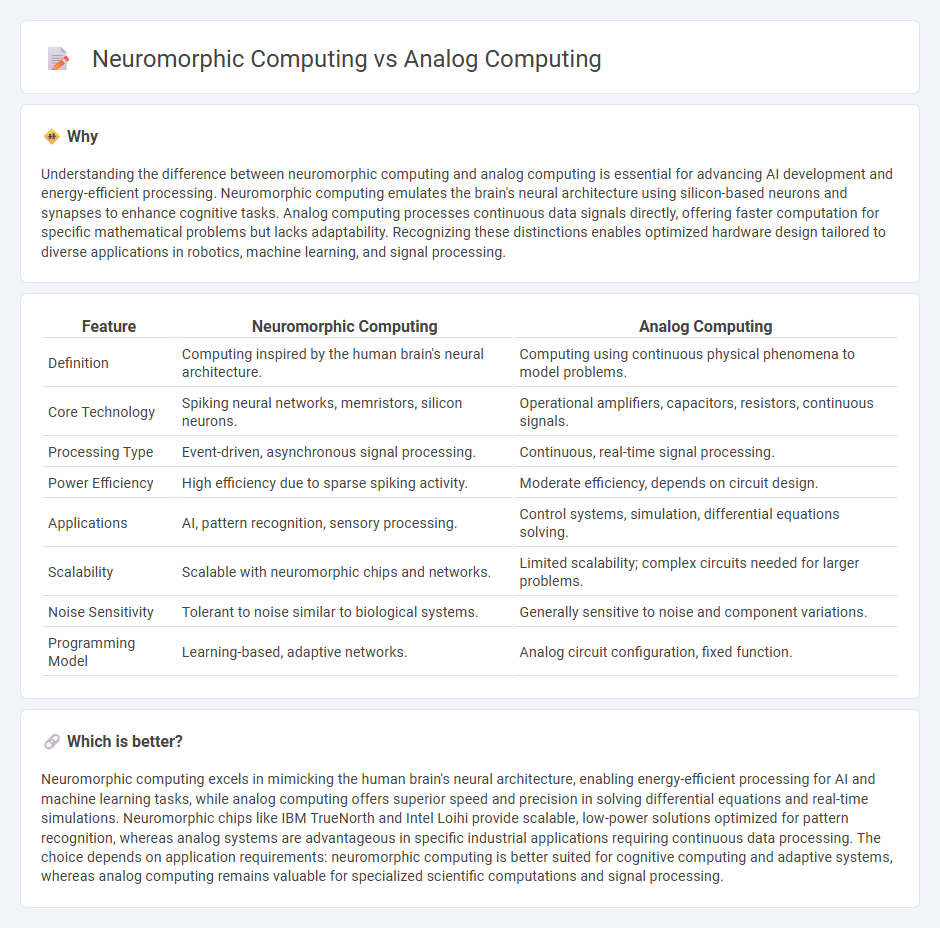
Neuromorphic computing mimics the neural architecture of the human brain, leveraging spiking neural networks to process information efficiently and adaptively. Analog computing, by contrast, performs calculations using continuous physical quantities, excelling in real-time signal processing and solving differential equations. Explore the cutting-edge distinctions and applications of these innovative computing paradigms here.
Why it is important
Understanding the difference between neuromorphic computing and analog computing is essential for advancing AI development and energy-efficient processing. Neuromorphic computing emulates the brain's neural architecture using silicon-based neurons and synapses to enhance cognitive tasks. Analog computing processes continuous data signals directly, offering faster computation for specific mathematical problems but lacks adaptability. Recognizing these distinctions enables optimized hardware design tailored to diverse applications in robotics, machine learning, and signal processing.
Comparison Table
| Feature | Neuromorphic Computing | Analog Computing |
|---|---|---|
| Definition | Computing inspired by the human brain's neural architecture. | Computing using continuous physical phenomena to model problems. |
| Core Technology | Spiking neural networks, memristors, silicon neurons. | Operational amplifiers, capacitors, resistors, continuous signals. |
| Processing Type | Event-driven, asynchronous signal processing. | Continuous, real-time signal processing. |
| Power Efficiency | High efficiency due to sparse spiking activity. | Moderate efficiency, depends on circuit design. |
| Applications | AI, pattern recognition, sensory processing. | Control systems, simulation, differential equations solving. |
| Scalability | Scalable with neuromorphic chips and networks. | Limited scalability; complex circuits needed for larger problems. |
| Noise Sensitivity | Tolerant to noise similar to biological systems. | Generally sensitive to noise and component variations. |
| Programming Model | Learning-based, adaptive networks. | Analog circuit configuration, fixed function. |
Which is better?
Neuromorphic computing excels in mimicking the human brain's neural architecture, enabling energy-efficient processing for AI and machine learning tasks, while analog computing offers superior speed and precision in solving differential equations and real-time simulations. Neuromorphic chips like IBM TrueNorth and Intel Loihi provide scalable, low-power solutions optimized for pattern recognition, whereas analog systems are advantageous in specific industrial applications requiring continuous data processing. The choice depends on application requirements: neuromorphic computing is better suited for cognitive computing and adaptive systems, whereas analog computing remains valuable for specialized scientific computations and signal processing.
Connection
Neuromorphic computing mimics the neural architecture of the human brain using analog circuits that process information through continuous signals rather than binary states, enhancing energy efficiency and processing speed. Analog computing provides the hardware foundation for neuromorphic systems by enabling real-time signal processing and adaptive learning capabilities. This synergy accelerates advancements in artificial intelligence applications, robotics, and sensory data interpretation by closely replicating biological neural networks.
Key Terms
Signal Processing
Analog computing processes continuous signals through electrical circuits that emulate mathematical operations, excelling in real-time signal processing applications due to low latency and high energy efficiency. Neuromorphic computing, inspired by neural architectures, uses spiking neural networks to mimic brain-like signal encoding and processing, offering adaptive learning capabilities and robustness in noisy environments. Explore how these paradigms reshape the future of signal processing technologies.
Synaptic Architecture
Analog computing uses continuous voltage levels to perform calculations, mimicking physical processes, while neuromorphic computing leverages brain-inspired synaptic architecture to emulate neural networks with high efficiency and adaptability. Synaptic architecture in neuromorphic systems employs memristors or capacitors to simulate synaptic weights, enabling event-driven, low-power computation that closely replicates biological signal transmission. Explore the intricate distinctions in synaptic design and performance to understand how these technologies are transforming computational paradigms.
Physical Realization
Analog computing relies on continuous physical variables such as voltages or currents to model and solve mathematical problems, typically implemented using operational amplifiers and capacitors on electronic circuits. Neuromorphic computing mimics the structure and function of biological neural networks using specialized hardware components like memristors and spiking neurons to achieve energy-efficient and parallel information processing. Explore more about how these physical realizations impact computing performance and applications.
Source and External Links
Analog computer - Wikipedia - Analog computers use continuous physical phenomena like electrical or mechanical quantities to model and solve problems, contrasting with digital computers that use discrete values.
Analog Computing - Mythic AI - Modern analog computing systems perform high-speed, energy-efficient calculations directly inside memory arrays, making them especially useful for intensive neural network operations.
Why the Future of AI & Computers Will Be Analog - Analog computers like the MONIAC use physical models--such as water flow representing money--to simulate and solve complex real-world systems with continuous variables.
 dowidth.com
dowidth.com